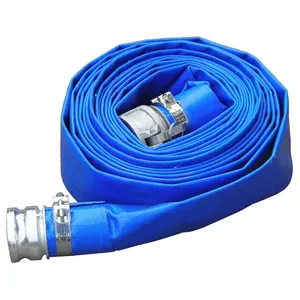

2 Inch Layflat Canvas Hose Pipe Irrigation 50mm Ldpe Layflat Hose Watering Irrigation Water Flat Hose




















From gardening to industrial applications, hoses play a crucial role. However, not all hoses are created equal. This article explores the unique characteristics of traditional hoses and their modern counterpart, the flat hose. We delve into their evolution, key features, benefits, practical applications, and potential drawbacks. We also discuss why consumer preferences are increasingly favoring flat hoses.
Traditional garden hoses, available in lengths of 25 to 100 feet, are versatile tools. They are typically made from either vinyl, which is less expensive but prone to kinking and wearing out, or rubber, which is more durable but heavier. Conversely, flat hoses, which resemble a smaller version of a fireman’s hose, are lightweight and easy to store. They remain flat until water is turned on. However, they are usually made of vinyl, which means they kink easily and may not have a long lifespan. Flat hoses are best for straight lines and don't perform well around corners.
The evolution of hoses has been significant, starting from the invention of the 'brandslang' or fire hose, which revolutionized firefighting. Initially, hoses were made from oxen gut, a concept dating back to 400 BC. The first modern hose was developed in the 1670s, paving the way for the development of flat hoses, which are more durable and efficient.
Flat hoses, also known as lay flat hoses, are highly flexible and resistant, capable of transporting high volumes of water quickly and efficiently. They can bridge the gap between a break and repair, providing crucial time for hard pipe repair. A flat hose is also safer and more effective in flooded areas, allowing for above-ground water transportation. They are made of a material that can withstand the pressure of water main breaks and can be used across streets and sidewalks.
Flat hoses offer numerous benefits over traditional hoses. They provide faster response times, making them a critical tool in emergency situations. They can transport a high volume of water quickly and efficiently, making them ideal for handling disasters or water main breaks. They are flexible, allowing for easy deployment in various field conditions. Moreover, they are safe and effective for above-ground water transportation, especially in flooded areas. These advantages make flat hoses a preferred choice for many industrial applications.
Flat hoses are incredibly practical in various applications. They are particularly useful in construction and irrigation roles where water transportation is challenging. One significant application is in flood clean-up efforts. In such scenarios, a water pump sucks up water from the flooded area, and a flat hose discharges it to a safe area or flood plain, often several hundred meters away. These hoses can be quickly and easily joined together with lever lock couplings, allowing you to create the perfect length of hose for the task at hand.
Despite some drawbacks, consumer preferences are increasingly favoring flat hoses. Their flexibility, resistance, and ability to transport high volumes of water quickly and efficiently make them a popular choice in various applications.
While flat hoses are lightweight, drain well, and are easy to store, they do have their drawbacks. Typically made of vinyl, flat hoses tend to kink easily and may not have a long lifespan. They are best suited for straight lines and struggle around corners. Therefore, while they offer certain advantages, their material composition and limited flexibility can pose challenges in their usage.
In conclusion, the flat hose, with its high flexibility, resistance, and ability to transport high volumes of water quickly, is increasingly becoming the preferred choice over traditional hoses. Its applications in various fields, especially in emergency situations and challenging environments, underscore its practicality and efficiency. However, it's important to note that flat hoses are not without their drawbacks, such as their tendency to kink and their limited lifespan. Despite these challenges, the evolution from traditional to flat hoses signifies a shift towards more efficient and adaptable tools in water transportation, highlighting the continuous innovation in this field.